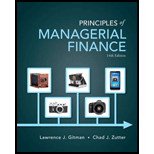
a)
To compute: The net proceeds.
Introduction:
Flotation cost includes two components the underwriting charges and brokerage fees. The flotation cost helps to reduce the total proceeds received by the firm. Total proceeds would be paid from the bond funds. The flotation cost is the difference between the total proceeds and net proceeds.
b)
To determine: The cash flows over the maturity of bonds.
Introduction:
Every firm requires capital to fund their long-term investments. The typical sources of capital for a firm include debt and equity. Firms often raise their capital by selling securities such as common stock,
c)
To calculate: The before-tax and after-tax cost of debt.
Introduction:
The before-tax cost of debt refers to the
d)
To calculate: The before-tax and after-tax cost of debt using approximation formula.
Introduction:
The before-tax cost debt is the rate of return the firm must pay on a new borrowing. The after-tax cost of a debt is the cost after deducting the tax amount.
e)
To discuss: The comparison between the two approaches.
Introduction:
The before-tax cost of debt refers to the rate of return that the firm should pay on new borrowing. The after-tax cost of a debt is the cost after deducting the tax amount.
When after-tax cost of the debt is ri and rd is the before-tax cost of a debt, with the tax rate of the firm T, the before-tax cost can be converted to after-tax cost by using the following equation,
Want to see the full answer?
Check out a sample textbook solution
Chapter 9 Solutions
Principles of Managerial Finance (14th Edition) (Pearson Series in Finance)
 Essentials Of InvestmentsFinanceISBN:9781260013924Author:Bodie, Zvi, Kane, Alex, MARCUS, Alan J.Publisher:Mcgraw-hill Education,
Essentials Of InvestmentsFinanceISBN:9781260013924Author:Bodie, Zvi, Kane, Alex, MARCUS, Alan J.Publisher:Mcgraw-hill Education,

 Foundations Of FinanceFinanceISBN:9780134897264Author:KEOWN, Arthur J., Martin, John D., PETTY, J. WilliamPublisher:Pearson,
Foundations Of FinanceFinanceISBN:9780134897264Author:KEOWN, Arthur J., Martin, John D., PETTY, J. WilliamPublisher:Pearson, Fundamentals of Financial Management (MindTap Cou...FinanceISBN:9781337395250Author:Eugene F. Brigham, Joel F. HoustonPublisher:Cengage Learning
Fundamentals of Financial Management (MindTap Cou...FinanceISBN:9781337395250Author:Eugene F. Brigham, Joel F. HoustonPublisher:Cengage Learning Corporate Finance (The Mcgraw-hill/Irwin Series i...FinanceISBN:9780077861759Author:Stephen A. Ross Franco Modigliani Professor of Financial Economics Professor, Randolph W Westerfield Robert R. Dockson Deans Chair in Bus. Admin., Jeffrey Jaffe, Bradford D Jordan ProfessorPublisher:McGraw-Hill Education
Corporate Finance (The Mcgraw-hill/Irwin Series i...FinanceISBN:9780077861759Author:Stephen A. Ross Franco Modigliani Professor of Financial Economics Professor, Randolph W Westerfield Robert R. Dockson Deans Chair in Bus. Admin., Jeffrey Jaffe, Bradford D Jordan ProfessorPublisher:McGraw-Hill Education





